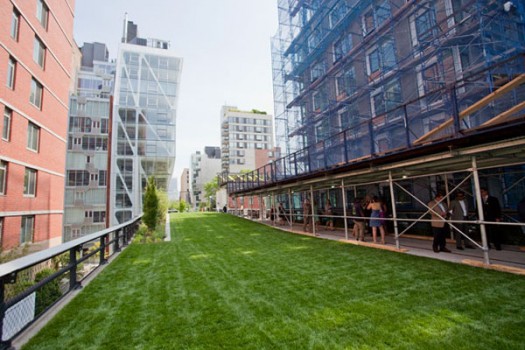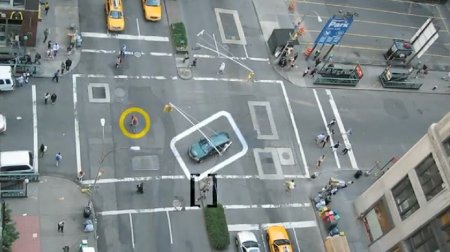
Celebrate ten years of Urban Omnibus and support ten more years of fresh, independent perspectives on citymaking with a donation today!
Celebrate ten years of Urban Omnibus and support ten more years of fresh, independent perspectives on citymaking with a donation today!

Photo by Jake Dobkin via Gothamist
HIGH LINE PHASE TWO NOW OPEN
Section 2 of the High Line is open to the public after a surprise soft launch on June 7th, between 20th to 30th Street along 10th Ave. The latest phase has doubled the length of the park to one mile. Some of the best new features to check out: the 4,900 square foot 23rd Street Lawn; an elongated, wooden radial bench (between West 28th and 29th Streets); and the 26th Street Viewing Spur, a glass framed lookout over West 26th Street with cascading teak sitting steps. See the official High Line site for more information on Section 2.
BATTLE FOR BROOKLYN REVIEWED
Norman Oder, resident expert on Atlantic Yards and author of the watchdog blog Atlantic Yards Report, recently reviewed Michael Galinsky and Suki Hawley’s documentary on the seven-year development controversy, Battle for Brooklyn. Oder finds the film to be “most valuable in the camera’s witness to the palpable insincerity and cold-blooded indifference of the developer-government alliance” and wonders if Ratner’s deputy Bruce Bender asked the right questions. Read Oder’s full film review over on Dissent and his comment on Forest City Ratner’s response to the film.

BAD HABITS = DANGEROUS STREETS
SVA Masters student Ron Gabriel has created a compelling video campaign called “3 Way Street” drawing on the dangerous behavioral tendencies bikers, people and cars play out on NYC streets. Gabriel’s project exposes how “pedestrians jaywalking, cyclists running red lights and motorists plowing through crosswalks” make our streets unsafe. Catch the cleverly annotated video here.
WHAT’S NEXT FOR SOUTH STREET SEAPORT
Gotham Gazette covers the latest land use controversy over plans for South Street Seaport, following a 40-year string of unsuccessful development strategies. The Howard Hughes Corporation has been in preliminary discussion with SHoP Architects to redevelop the neighborhood, which, although it has some of the oldest architecture in Manhattan, has been home to many struggling businesses over past few decades. A 2008 plan sought to tear down the Pier 17 mall and construct a huge condominium, which was heavily critiqued by Community Board 1. Competing area demands like public retail needs and newer businesses like the New Amsterdam Market make for a complex design challenge. Stay tuned for updates and see the full story here.
IS LEED TOO POWERFUL?
On ArchitectureBoston, Michael Liu outlines the debate surrounding the legitimacy of LEED certification. Starting in 2010, Henry Gifford filed a class-action lawsuit against the non-profit US Green Building Council (USGBC) on a number of accounts, claiming USGBC’s claims to improved energy performance of LEED-certified buildings were unsubstantiated and contributed to a defrauding of the public en masse over the actual benefits of LEED-certified buildings. LEED-certification currently charges significant sums for construction and professional credits, turning LEED into what Gifford calls “a fee-generating monopoly.” Gifford provides a relevant contribution by opening up discourse around who makes what rules and unpacking the added complexity of charging money for institutionalized standards. Nevertheless, LEED certification also represents the need to formalize and codify design standards to move toward a sustainable future. Gifford points out that we need to be wary of how these standards are met; he critiques the “process of certifying buildings and the creation of a fee-generating bureaucratic structure” rather than green design standards themselves. Read Michael Liu’s full op-ed here.
HIGH-TECH TOURISM
CultureNOW, an organization formed in the immediate aftermath of 9/11 specifically to illustrate the cultural and historical richness of Lower Manhattan, has mapped out the history, art and architecture of New York’s public realm to create a “museum without walls” iPhone app. CultureNOW President Abby Suckle calls the app, which won an honorable mention in the New York City’s 2011 BigApps 2.0 contest, a “treasure hunt, almost like urban archaeology.” Users can explore with maps, photos, tour routes and renderings of former buildings, all while listening to timely podcasts from experts like Parks Commissioner Adrian Benepe, Pratt Professor Bill Menking and architect Hugh Hardy. Download the app here.
EDGAR ALLEN POE AND DESIGN EXCELLENCE IN THE BRONX
The new Poe Park Visitor Center, located in the Bronx between the Grand Concourse and Kingsbridge Road, sits on a 2.3 acre park that was home to the last residence of famed author Edgar Allen Poe. The visitor center is the first parks project to be completed from the Bloomberg Administration’s Design and Construction Excellence Initiative. Designed by architect Toshiko Mori, the new center is a 5,400-square-foot visitor center that includes a gathering space for community use and a display area showcasing the Poe farmhouse vista. A modest structure, Mori did not want to overwhelm Poe’s tiny farmhouse. See Archinect’s full coverage on the center.
EVENTS + TO DOs

BY THE CITY / FOR THE CITY CALL FOR DESIGNS
Last month, we told you about Institute for Urban Design’s call for ideas for its By the City/ For the City project, which asked New Yorkers to share their ideas for how to improve NYC. IfUD has now opened up the second phase of the program to designers who want to visualize these ideas. The ideas and designs will eventually be published in a public atlas. The Call for Designs will be open through July 14th. Submit your designs and visit the competition’s site here.
CITY AS STAGE: CONVERSATION ON ‘FORECLOSED’
On Saturday, June 11th, the Whitney will host a free, public platform lecture on Foreclosed: Between Crisis and Possibility, at 3pm at The Kitchen, 512 W 19th Street. As part of the exhibition Foreclosed: Between Crisis and Possibility, the discussion will explore urban space as a site of contestation and possibility. It will begin with a screening of Yto Barrada’s video Beau Geste (2009), followed by a conversation between Tania Bruguera (Artist), Peter Marcuse (Professor of Urban Planning, Columbia University), Damon Rich (Urban Designer, City of Newark) and Radhika Subramaniam (Curator, Parsons The New School for Design). See full details here.
.
The Roundup keeps you up to date with topics we’ve featured and other things we think are worth knowing about.
The views expressed here are those of the authors only and do not reflect the position of The Architectural League of New York.